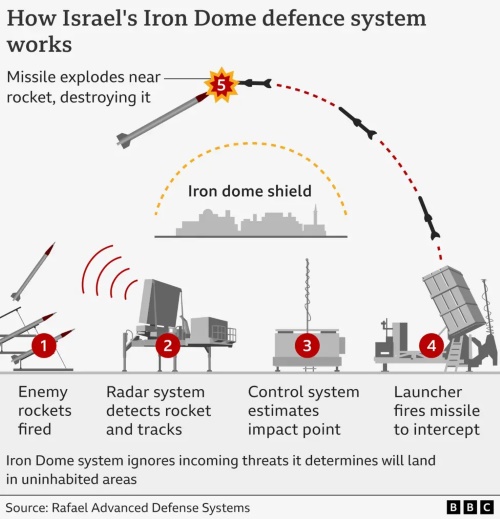In a bold move to enhance the security of the United States, President Donald Trump has announced the development of a U.S.-based Iron Dome missile defence system. Set to sign an executive order on January 27, 2025, this plan seeks to protect Americans from missile threats by introducing a system modelled after Israel’s highly successful Iron Dome.
What are Trump's initiatives to build the Iron Dome?
Highlights of Trump’s Iron Dome Initiative
- U.S.-Made Defense System: A missile defence shield to be entirely manufactured in the United States.
- Protection Against Short-Range Threats: Focused on defending against short-range missiles fired by regional adversaries.
- Immediate Action: Trump emphasized the urgency of building the system to enhance U.S. national defence.
What are the Features of the U.S. Iron Dome Initiative?
Features of U.S. Iron Dome :
| Feature | Details |
| System Development | U.S. version of Israel’s Iron Dome. |
| Manufacturing | Entirely produced within the U.S. to boost domestic industry. |
| Primary Threats Addressed | Short-range missiles, rockets, and artillery shells. |
| Significance | Enhances U.S. defence and protects citizens from missile threats. |
What Is Iron Dome?

Source: britannica
The First Line of Defense
The Iron Dome is a sophisticated missile defence system used by Israel to intercept short-range rockets and missiles. It's been deployed to protect Israel from regional threats like Hamas and Hezbollah.
Purpose: Intercept short-range rockets, shells, and mortars.
- Range: 4 km to 70 km
- Launchers: 3–4 launchers per battery, each with 20 interceptor missiles
- Interception Success Rate: ~90%
- Cost per Missile: Approx. $50,000
How does it work?
- Radar: Detects and tracks incoming rockets.
- Decision-making: Calculates which rockets pose a threat to populated areas.
- Intercept: Destroys threatening rockets mid-air, while non-threatening ones fall on open ground.

Source: Rafael Advance Defense System/BBC
Successfully Deployed:
- Deployed since 2011.
- Successfully intercepted thousands of rockets, including those from Hamas and Hezbollah.
Iron Dome Overview
| Details | |
| Origin | Developed by Israel for regional defence. |
| Primary Function | Intercepting rockets and short-range missiles. |
| Effectiveness | High interception rate, successful in multiple regional conflicts. |
| Deployment | Deployed by Israel in Gaza and Lebanon conflicts. |
What is Trump’s Vision in Strengthening U.S. Defense?
During his presidential campaign in 2024, Trump emphasized the importance of reinforcing U.S. defence mechanisms. His promise to build an Iron Dome-style air defence system is part of a broader strategy to enhance the country's missile defence infrastructure.
Trump’s stated that,“We need to protect Americans immediately”
Here is Trump’s Vision in detail:
- National Security Priority: Trump stressed the need to immediately implement this system for enhanced protection against missile threats.
- Local Manufacturing: Emphasized that the Iron Dome will be manufactured entirely in the USA, benefiting the U.S. economy.
- Limitations of the System: Critics point out that while the Iron Dome excels at short-range defence, it is not effective against long-range threats like intercontinental ballistic missiles (ICBMs).
Notes: What is ICBMs?Intercontinental Ballistic Missiles (ICBMs) are long-range missiles capable of travelling over 5,500 kilometres to deliver nuclear or conventional warheads. They follow a ballistic trajectory, launching into space before descending to the target.
Source: Army Technology Key Features:
Strategic Importance:ICBMs are central to nuclear deterrence, ensuring retaliation in case of attack. They are part of the "nuclear triad," alongside submarine-launched missiles and bombers, maintaining global power dynamics. |
What are the Challenges for Implementing the Iron Dome in the U.S.?
While the Iron Dome has proven successful in smaller-scale conflicts, experts remain cautious about its application to the United States, where the strategic landscape is significantly different.
Potential Challenges:
- Long-Range Missile Defense: The Iron Dome is not designed to defend against long-range threats, such as ICBMs, which are the primary concern for U.S. national security.
- Cost and Scalability: Developing and deploying the Iron Dome across the vast expanse of U.S. territory would require significant investment and infrastructure.
- Integration with Existing Systems: Integrating the Iron Dome with the United States’ existing missile defence systems, such as the Ground-based Midcourse Defense (GMD), will present technical and logistical challenges.
How Political Leaders reacts? Support or Criticism
Trump's executive order on defence faces mixed reactions. Supporters back the Iron Dome for missile defence, while critics highlight its limitations. His focus on military inclusivity adds complexity to defence policy debates.
Here is in details of their reactions:
| Political Reactions | Details |
| Support for Iron Dome | Advocates believe it is critical to defend against regional threats. |
| Criticism of System Limitations | Critics highlight the Iron Dome's inadequacy for long-range threats. |
| Other Military Changes | Trump plans reforms, including controversial policies on military inclusivity. |
What’s Next for the U.S. Defense?
As the U.S. moves forward with building the Iron Dome, it will need to:
- Evaluate the need for long-range missile defence systems like ICBM interceptors.
- Focus on cost-effectiveness and system integration with other defence technologies.
- Secure bipartisan support to ensure the successful implementation and funding of the program.
Conclusion: A Strategic Move in the U.S. Defense
President Trump's initiative to introduce a U.S.-based Iron Dome missile defence system represents a significant shift in U.S. defence strategy. By providing protection against short-range missile threats, the system aims to bolster national security. However, experts caution that the Iron Dome’s limitations against long-range missile threats like ICBMs might necessitate further advancements in U.S. defence systems.

Comments
All Comments (0)
Join the conversation